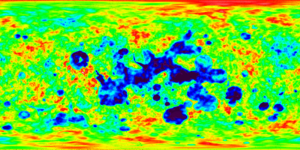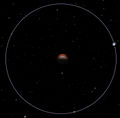Duna/pl
Duna Jest czwartą planetą systemu Kerbol. Jest odpowiednikiem Marsa, ma barwę czerwoną, i posiada czapy lodowe na biegunach. Posiada jednego naturalnego satelitę księżyc Ike. Ze względu na wzajemną bliskość, Ike i Duna znajdują się w synchronicznej rotacji.
Contents
Topografia
|
Duna jest planetą bogatą w żelazo, z dużymi wahaniami w wysokości terenu, co znacznie utrudnia znalezienie dobrego miejsca do lądowania. Lądowanie utrudnia również rzadka atmosfera która nie daje możliwości znacznego hamowania atmosferycznego (spadochron). Zalecane jest znaczne zwolnienie przed wejściem w atmosfere. a powierzchni w kilku miejscach znajdują się tzw. "Morza" dające się rozpoznać dzięki ciemniejszemu zabarwieniu powierzchni na wysokości dokładnie 0 m. TSą one najlepszymi terenami do lądowania dzięki niskiemu położeniu pozwalającej na efektywne hamowanie atmosferyczne. Oba bieguny posiadają bardzo duże pokrywy lodowe - efekt bardzo rzadkiej atmosfery. Centralne regiony układają się w kształt przypominający Europę. Powierzchnia Duny zawiera sporo easter eggów |
Atmosfera
|
Duna's atmosphere begins at 41,446 m. It is only 20% as dense as Kerbin's at altitude 0 and is even less dense (relative to Kerbin) at higher altitudes. Like all atmospheres in the game, Duna's atmosphere fades exponentially with increasing altitude (with a scale height of 3000 m). In general, the atmospheric pressure on Duna at an altitude expressed in meters is:[1] Parachutes work at lower efficiency than on Kerbin, making powered descent necessary when landing from orbit (unless your craft is a glider or just a pod with a parachute). The following table gives terminal velocities at different Duna altitudes. These are also the velocities at which a ship should travel for a fuel-optimal ascent from Duna, given the game's model of atmospheric drag.[2]
|
Orbital Statistics
The geosynchronous orbit of Duna is at an altitude of 0,00 m above Duna. The speed of the satellite is 0,00 m/s and it has an orbital period resonating with 1 Duna day (18.2 hours or 65517.859375 seconds). However, this orbit is not possible since it intersects with Ike's SOI.
For a semi-synchronous orbit of ½ Duna day (9.025 hours or 32490 seconds) an orbit of 0,00 m above Duna is needed with a velocity of 0,00 m/s.
Reference Frames
| Warp | 5x, 10x | 50x | 100x | 1000x | 10,000x | 100,000x |
| Minimum Altitude | above atmosphere | 60 km | 100 km | 300 km | 600 km | 800 km |
Gallery
- Duna projection.png
A false color Mercator projection of Duna's surface using MapSat.
Changes
- Initial Release
Trivia
- On the surface of Duna, there is a large monument carved in the likeness of a Kerbin face, alluding to the infamous "Face of Mars" discovered in the Cydonia Mensae region of Mars during the 1970's.
- Duna's name may be either a reference to its desert landscape or a shout-out to the Frank Herbert novel Dune.
- One anomalous feature on Duna is a small, pyramid-like hill emitting an SSTV signal. When decrypted, it shows a diagram-like image of three figures standing next to the hill itself, implying that Duna was once inhabited.
Notes
- ↑ A nuclear engine has a specific impulse of 220 in 1 atm, 800 in vacuum, and the following at various Duna altitudes:
altitude (m) 2 100 300 500 1460 2420 3000 4272 5000 10000 specific impulse 684.1 687.8 695.1 701.8 728.7 748.2 757.3 772.1 778.1 795.9 - ↑ http://forum.kerbalspaceprogram.com/showthread.php/6664-Mini-challenge-max-altitude-with-this-supplied-spacecraft?p=100912&viewfull=1#post100912







